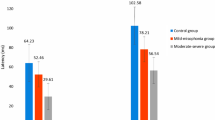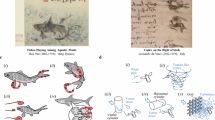Summary
-
1.
The small (anterior) tympanal membrane in the ear of the cricketGryllus campestris L. is non-functional in hearing (Fig. 4).
-
2.
The large (posterior) tympanum vibrates in its basic mode in the entire frequency range investigated (1–30 kHz).
-
3.
The velocity and the phase angle (sound pressure to vibration velocity) of the large tympanum are very much influenced by whether the ipsilateral spiracle is open or closed (Fig. 5).
-
4.
The velocity and the phase angle of the large tympanum are less influenced by the state of the contralateral spiracle. The experiments demonstrate, however, that sound waves in the frequency range from 1 to 22 kHz travel from the contralateral spiracle through the connecting tracheal tube to the back (internal) surface of the tympanum. The internal sound pressure (p b ) thus provided amounts to about 35% of the sound pressure (p f ) acting on the front (external) surface of the tympanum. This part ofp b is rather independent of frequency (Figs. 6 and 7).
-
5.
The velocity and the phase angle of the large tympanum are little influenced by sound transmitted through the contralateral (large) tympanum. Thep b thus provided amounts to 10–20% ofp f (Fig. 8).
Similar content being viewed by others
References
Bailey, W.J., Thomson, P.: Acoustic orientation in the cricketTeleogryllus oceanicus (Le Guillou). J. exp. Biol.67, 61–75 (1977)
Dambach, M.: Vibrationssinn der Grillen. I. Schwellenmessungen an Beinen freibeweglicher Tiere. II. Antworten von Neuronen im Bauchmark. J. comp. Physiol.79, 281–324 (1972)
Dragsten, P.R., Webb, W.W., Paton, J.A., Capranica, R.R.: Auditory membrane vibrations: measurements at sub-Angstrom levels by optical heterodyne spectroscopy. Science185, 55–57 (1974)
Friedman, M.H.: A light and electron microscopic study of sensory organs and associated structures in the foreleg tibia of the cricket,Gryllus assimilis. J. Morphol.138, 263–327 (1972)
Hill, K.G., Boyan, G.S.: Directional hearing in crickets. Nature262, 390–391 (1976)
Johnstone, B.M., Saunders, J.C., Johnstone, J.R.: Tympanic membrane response in the cricket. Nature227, 625–626 (1970)
Michel, K.: Das Tympanalorgan vonGryllus bimaculatus Degeer (Saltoria, Gryllidae). Z. Morph. Tiere77, 285–315 (1974)
Michelsen, A.: The physiology of the locust ear. I. Frequency sensitivity of single cells in the isolated ear. II. Frequency discrimination based upon resonances in the tympanum. III. Acoustical properties of the intact ear. Z. vergl. Physiol.71, 49–128 (1971)
Michelsen, A., Larsen, O.N.: Biophysics of the ensiferan ear. I. Tympanal vibrations in bushcrickets (Tettigoniidae) studied with laser vibrometry. J. comp. Physiol.123, 193–203 (1978)
Miller, L.A.: Directional hearing in the locustSchistocerca gregaria. J. comp. Physiol.119, 85–98 (1978)
Nocke, H.: Physiological aspects of sound communication in crickets (Gryllus campestris L.). J. comp. Physiol.80, 141–162 (1972)
Nocke, H.: Physical and physiological properties of the tettigoniid (“grasshopper”) ear. J. comp. Physiol.100, 25–57 (1975)
Seymour, C, Lewis, D.B., Larsen, O.N., Michelsen, A.: Biophysics of the ensiferan ear. II. The steady-state gain of the hearing trumpet in bushcrickets. J. comp. Physiol.123, 205–216 (1978)
Young, D., Ball, E.: Structure and development of the auditory system in the prothoracic leg of the cricketTeleogryllus commodus (Walker). Z. Zellforsch.147, 293–312 (1974)
Zhantiev, R.D., Kalinkina, I.N., Tshukanov, V.S.: The characteristics of the directional sensitivity of tympanal organs inGryllus bimaculatus Deg. (Orthoptera, Gryllidae). Rev. Entomol. USSR54, 249–257 (1975)
Zhantiev, R.D., Tshukanov, V.S.: Frequency characteristics of tympanal organs of the cricketGryllus bimaculatus Deg. (Orthoptera, Gryllidae). Vestnik Moscow Univ., Ser. Biol.2, 3–8 (1972)
Author information
Authors and Affiliations
Additional information
We are grateful to O. Juhl Pedersen, Knud Rasmussen and Simon Boel Pedersen of the Acoustics Laboratory, The Technical University of Denmark for advice on physical problems and to Dr. Lee A. Miller for comments on the manuscript. The work was supported by NATO and the Danish Natural Science Research Council.
Rights and permissions
About this article
Cite this article
Larsen, O.N., Michelsen, A. Biophysics of the ensiferan ear. J. Comp. Physiol. 123, 217–227 (1978). https://doi.org/10.1007/BF00656874
Accepted:
Issue Date:
DOI: https://doi.org/10.1007/BF00656874




